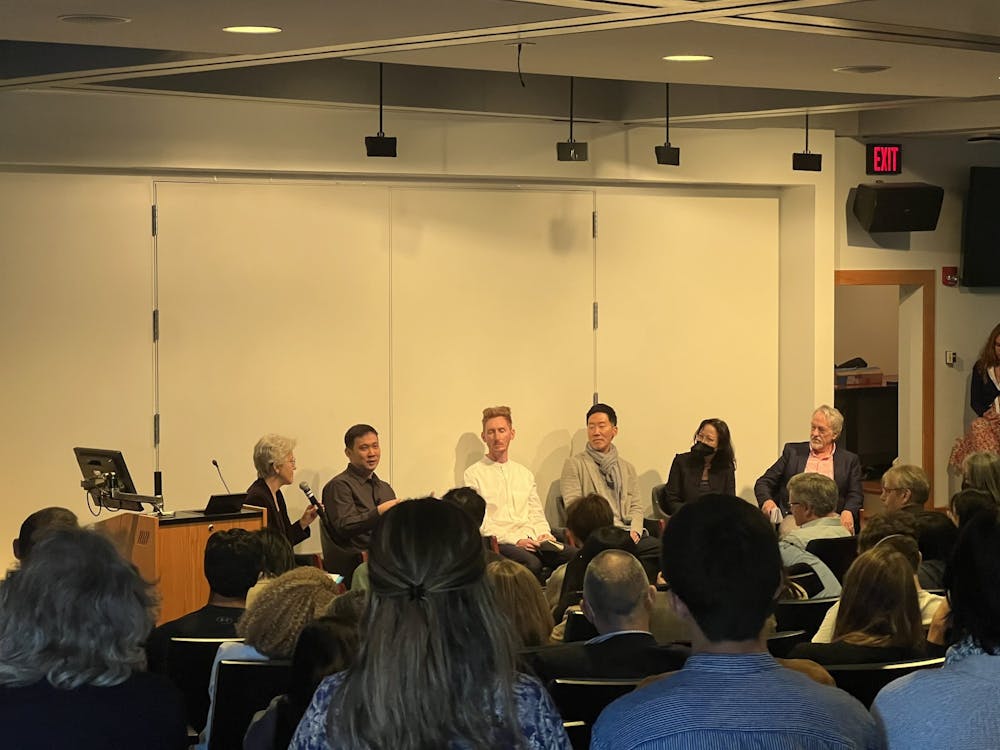On Friday, Sept. 23, Ryūsuke Hamaguchi came to Princeton’s campus, kicking off the weeklong “Conversations” that began with the Humanities Council’s Fall 2022 Belknap Global Conversation at Betts Auditorium. Throughout the week in residence — sponsored by Department of East Asian Studies, the Department of Comparative Literature, the Program in East Asian Studies, and the Committee for Film Studies — the award-winning director is leading a series of workshops where some students will create and present short films. In tandem, the Princeton Garden Theatre is holding multiple screenings of a mini retrospective of his most recent films.
Hamaguchi’s visit follows the breakout success of his latest feature film, “Drive My Car,” which won the Academy Award for Best International Feature Film at last spring’s ceremony and Best Screenplay at the Cannes Film Festival. The three-hour film is meditative and highly emotional, capturing the hearts and minds of critics and viewers across the world.
The campus community buzzed with excitement from the Japanese director’s presence at the Bellknap Global Conversation. At the jam-packed Betts Auditorium, Hamaguchi fielded questions about his process from four panelists: Associate Professor in East Asian Studies Steven Chung, Associate Professor of Music Gavin Steingo, Professor of English Anne Cheng ’85, and Professor of Comparative Literature Thomas Hare ’75.
Hamaguchi began the event by thanking the University in English for having him back, which he then quickly followed with “Let me speak in Japanese.”
Through translation provided by Tara McGowan ’90, Hamaguchi began discussing his process with the four panelists. The first topic of conversation was his documentary work – his initial entryway into the world of cinema.
Following Japan’s triple disaster of 2011 (an earthquake, tsunami, and nuclear meltdown), Hamaguchi began interviewing victims of the crisis, typically multiple people at once. These interview resulted in multiple documentaries directed by himself and Ko Sakai, including “The Sound of Waves,” “Voices from the Waves: Shinchimachi,” “Voices from the Waves: Kesennuma,” and “Storytellers.” While working to reconcile with the tragedy that had struck his home country, he came to realize that both the trauma of the disasters and the shared histories of the interviewees' relationships could come through authentically on film. He found that although these interviewees knew each other well, they had never had these conversations in real life. When he saw these emotions peek through, it was unlike anything he had ever seen in fiction before, and he immediately wanted to incorporate that raw sincerity into his narrative films.
Hamaguchi credits folklore scholar Kazuko Ono, the subject of the documentary “Storytellers,” as the person who revealed this to him. Ono interviewed many survivors in the wake of the disasters, showing that by listening with wholehearted respect, it was possible to pull genuine emotions out of her interviewees. Hamaguchi utilizes these same techniques with his actors to imbue his work with its signature authenticity, blurring the lines between film and documentary.
In fact, this obsession with realness seems to define much of his work. Like the lead character of “Drive My Car,” a stage actor-director named Yūsuke Kafuku, Hamaguchi insists that his actors repeat their lines over and over again to rehearse. He believes that an actor should know more about their character than the audience — he even provided actors with supplemental texts containing more information about the characters than is present in the screenplay. Hamaguchi wants the dialogue to become a part of the actors’ bodies because their interactions keep his films engaging for the audience. It’s their almost intangible interiority that counts the most.

Hamaguchi finds these interior moments — specifically the internal shift in emotions — most present in the musicality of the human voice. When a character is talking for an extended period of time, he looks for moments when the voice is particularly beautiful. Sometimes, he thinks the voices sound so great that background music isn’t necessary. He jokes that he uses music when the directing is not going so well. Many directors avoid including too much dialogue because so much believability is found in the voice; it can be crippling to the film’s sense of immersion if not perfect. Hamaguchi is not afraid. He dives in head first.
Hamaguchi’s films are famous for being especially long. When asked why, he self-deprecatingly quipped, “Basically I think shorter films are better.” He believes that, despite their length, each of his films is as short as it can be. “Drive My Car” is about three hours long, with an opening credits sequence that arrives around 40-minutes into the film. His love of dialogue is partially responsible for that runtime, along with his desire to include as many different shots of actors listening as possible. But beyond that, his unique pace serves a different purpose. He believes that good storytelling is when the audience can fill in the world with you. For this reason, what is not said in a scene is incredibly important; long, extended moments of silence are just as integral to Hamaguchi as an emotionally-wrought monologue.
Hamaguchi ended the talk by answering audience questions. An audience member asked how satisfied he was with the authenticity of “Drive My Car.” He said he felt about 70 percent successful. For an artist like him, there is always work to be done.
Tyler Wilson is a contributing writer for The Prospect and Humor at the ‘Prince.’ He can be reached at tyler.wilson@princeton.edu, or on Instagram at @tylertwilson.

Editor’s Note: This piece has been updated to include additional information regarding the co-hosts of the series.








